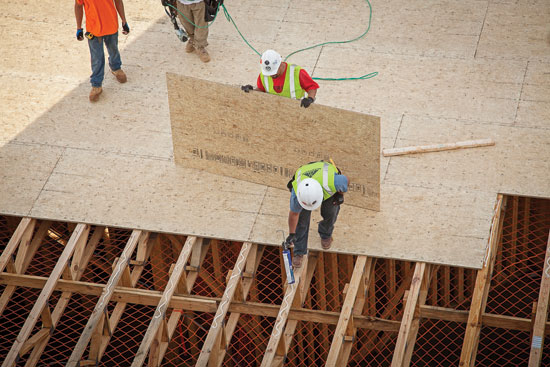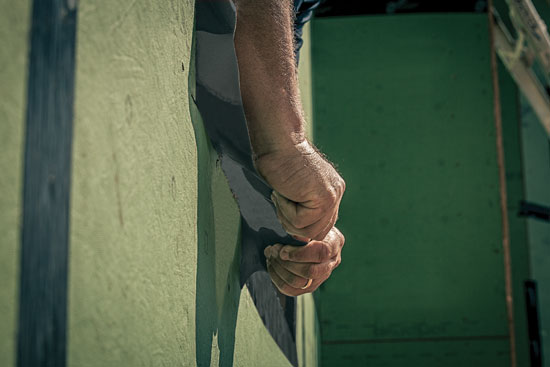Mitigating Risk with High-Performance Structural Wood Panels
Walls and Roofs—Integrated Systems vs. Building Wrap Products
Designing moisture resistance into wall and roof systems is also key. Three subcomponents, all of which pertain to the adequacy of the moisture and air barrier, must be considered. First is the bulk water barrier, which keeps water from the outside from getting to the inside. Bulk water entering a structure can not only damage contents, but can lead to mold and structural failure if structural elements are not allowed to dry properly. Next is vapor permeability. This allows airborne moisture from showers, kitchens, and occupants to migrate through the building envelope to the outside. Controlling exfiltration, which carries air out of the building, is just as important as controlling infiltration. Air leakage can carry moisture into unwanted places, which could lead to rot, mold, increased energy loss, and indoor air quality problems. An air barrier system is composed of materials that form and seal the building envelope to prevent unwanted air movement. To be effective, the system must be continuous with no holes, openings, or penetrations and resistant to air pressure differentials. Attention should be paid particularly to inadequately sealed penetrations in the exterior wall, such as electrical outlets or mechanical openings—places where air typically leaks into and out of a building.

Photo © 2013 Huber Engineered Woods LLC. Photo used with permission of Huber Engineered Woods LLC.
High-performance engineered wood panels maintain strength and stiffness values, even after exposure to elements throughout construction, which ultimately helps provide consistently quiet, stiff finished floors.
The traditional methods of managing moisture and air intrusion such as caulking, building felt, and traditional building wraps can be problematic. They must be properly sealed at all penetrations, which is often complicated and time consuming. Building wraps can be prone to tearing from mishandling or exposure to the elements, particularly wind. There is often poor adhesion of flashing material and tape as well as complex installation details to accommodate in order to effectively install some of these products. Some perforated wraps may result in the passage of water and air or have low abrasion and tear resistance. With macro porous perforated building wraps, the dilemma is that the macro holes in the film provide vapor permeance, but sacrifice air and water resistance. Some micro-porous products may not be sufficiently abrasion- and tear-resistant. Asphalt papers and felts, on the other hand, may be more moisture resistant but less pliable. Rolled- or sprayed-on, water-resistive barriers are another option, with the main advantage being that these applications will stay on the wall without ripping or tearing. However, these products must be installed at a specific thickness, require different installation instructions for different substrates, require a dry time, may require multiple coats, have temperature restrictions, and must be applied to a completely dry surface—a potential problem during rainy seasons. Achieving consistency can be challenging. All of these processes require multiple steps to achieve high-quality air and moisture protection and leave room for error during the installation process.
In view of these problems, one manufacturer is offering a new approach: high-performance panels with an integrated weather-resistive barrier (WRB) that install easily with minimal environmental installation restrictions. Water has the opportunity to become trapped between traditional building wrap and a structural panel since the wrap is not fully sealed to the surface of the panel. With high-performance panels that have integrated WRBs, there is no risk of water being trapped between the panel and the water-resistive layer as they are fused together. Further, integrated systems are specially engineered to allow permeability. To allow for outward drying, a water-resistive barrier must have a higher permeance.
Because the sheathing's WRB is permanently fused to each panel, there is little to no risk of it being ripped or torn, ensuring that the structure panel is not exposed to potential damage or detrimental weather. By contrast, the wood surface of a traditional OSB and building wrap system can be compromised when a building wrap is ripped or torn, as a break in the wrap may expose the entire wood surface underneath to detrimental weather or moisture.
Flashing Tape—The Critical Element
All systems, whether they are integrated systems or traditional OSB panels installed with loose laid building wrap, require fasteners to secure their positioning, sealing tape to seal the edges, and flashing tape to integrate with other building elements. Each manufacturer will provide a compatible tape that seals the edges of its weather-resistant barrier system to each other. The main requirements are ease of use, and longevity when exposed to the elements and the effects of UV radiation. Where manufacturers differentiate themselves is in the area of flexible flashing tapes, and how they integrate other building elements with the weather-resistant barrier.
There are two critical areas where the continuity of the weather-resistant barrier can be compromised by a poorly designed or installed flashing system. These are windows and protrusions. Only recently have windows attracted the kind of attention that is warranted. From metal flashing pans, to advanced sealants, to recent developments in flexible window sill applications, windows and window flashing are now recognized as a significant area of risk when it comes to keeping water where it belongs—on the outside of the building. Stretchable acrylic-based sealant tape allows for one-piece window pans with no voids, easily solving one of the most difficult risks of water infiltration.
Protrusions are most often created by mechanical systems, which must have access between the inside and outside of a structure. Any penetration in the building envelope creates a risk for either moisture penetration or air flow, both of which can cause structural damage if left unsealed and unaccounted for. Again, stretchable acrylic-based sealant tapes provide a high-quality solution for preventing leaks between the building envelope and any mechanical protrusion.
Stretchable flashing tape is the next generation of effective weather proofing with significant ease-of-use advantages over traditional metal flashings and non-flexible flashing tape. Tapes have evolved over the years from asphalt and butyl tapes to acrylic tapes, which have grown in popularity in construction applications. Today's acrylic tapes are engineered for superior durability and temperature range and have been shown to perform so well that they are routinely used not only in the construction field but in high-performance applications in the automotive, marine, and aviation industries as well. Tapes with acrylic adhesives, either water-based, solvent-based, or “solid,” are becoming increasingly popular.
The least expensive acrylic tape adhesive is water-based; however, this type of tape may not bond to as many types of substrates as the other varieties. According to BuildingGreen.com, “solid acrylic adhesives can form the strongest adhesive bonds at a wide range of temperatures and even achieve adhesion to damp or wet substrates.”4 Without solvents, the tapes do not become brittle over time. Made of highly polar molecules that pull the adhesive into the substrate, advanced acrylic tapes are formulated to flow into every crevice, increasing total contact area, and producing a permanent bond for a lasting seal that is considerably stronger than traditional asphalt and butyl tapes. With both robust adhesion and cohesion, advanced acrylic tapes are internally strong—intertwined polymer chains provide excellent internal strength, adding to the overall reliability of the seal.

Photo © 2014 Huber Engineered Woods LLC. Photo used with permission of Huber Engineered Woods LLC.
Next-generation stretch tape for complex flashing areas make for easy installation even on curved architectural features and penetrations.









